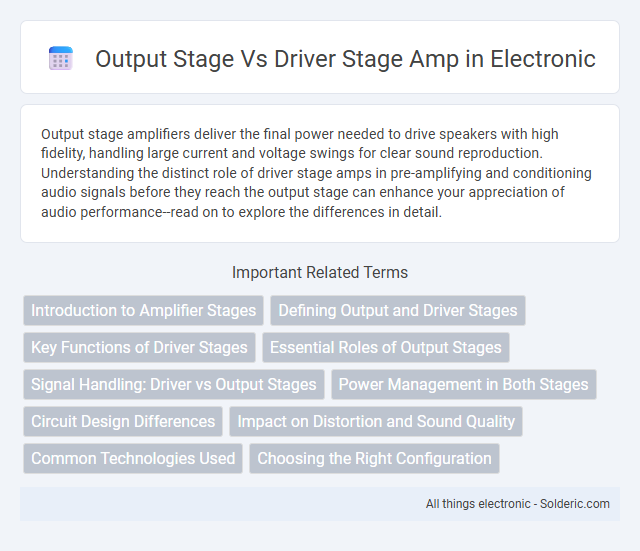Output stage amplifiers deliver the final power needed to drive speakers with high fidelity, handling large current and voltage swings for clear sound reproduction. Understanding the distinct role of driver stage amps in pre-amplifying and conditioning audio signals before they reach the output stage can enhance your appreciation of audio performance--read on to explore the differences in detail.
Comparison Table
| Aspect | Output Stage Amplifier | Driver Stage Amplifier |
|---|---|---|
| Function | Delivers final power to the load (e.g., speakers) | Provides voltage/current gain to drive the output stage |
| Power Handling | High power capability | Moderate to low power |
| Impedance | Low output impedance for efficient load driving | Intermediate impedance to interface with output stage |
| Voltage Gain | Usually low voltage gain; mainly current gain | High voltage gain |
| Current Gain | High current gain | Moderate current gain |
| Complexity | Simple circuit focused on power delivery | More complex circuit for signal conditioning |
| Typical Components | Power transistors, MOSFETs | Small signal transistors, driver ICs |
| Thermal Management | Critical; requires heatsinks or cooling | Less critical |
| Role in Amplifier Chain | Final amplification stage before the load | Intermediate stage between preamplifier and output stage |
Introduction to Amplifier Stages
The output stage of an amplifier delivers the final power signal to the load, often using transistors or tubes designed for high current and low distortion, ensuring efficient signal transfer. The driver stage serves as an intermediate amplification phase, providing the necessary voltage gain and driving capability to properly feed the output stage components. Understanding the roles of each stage is crucial for designing amplifiers with optimal performance, gain stability, and sound quality.
Defining Output and Driver Stages
The output stage in an amplifier is responsible for delivering the final amplified signal to the load, typically designed to provide high current and power capacity for driving speakers or other devices. The driver stage serves as the intermediate amplification stage, providing the necessary voltage gain and driving capability to adequately control the output stage transistors. Distinguishing these stages is crucial for understanding amplifier design, as the driver stage ensures signal integrity and linearity before power amplification occurs in the output stage.
Key Functions of Driver Stages
Driver stages in amplifiers primarily serve to amplify the signal to a level sufficient to properly drive the output stage, ensuring accurate signal transmission without distortion. These stages provide voltage gain and impedance matching, preparing the signal for the high current demands of the output transistors. Your audio system relies on a well-designed driver stage for maintaining signal integrity and achieving optimal power amplification efficiency.
Essential Roles of Output Stages
Output stages in amplifiers are critical for delivering the amplified signal to the load with minimal distortion, ensuring signal integrity and power efficiency. They manage the final voltage and current levels, providing the necessary driving capability to speakers or other devices. Unlike driver stages, which prepare and boost signals within the circuit, output stages handle high power and maintain linearity crucial for audio fidelity and device protection.
Signal Handling: Driver vs Output Stages
Output stages in amplifiers handle high current delivery to speakers and manage the final signal power output, ensuring minimal distortion and stable voltage swing. Driver stages process lower power signals and provide necessary voltage gain and impedance matching to effectively control the output transistors. Your amplifier's performance relies on the seamless interaction between driver stages shaping the signal and output stages delivering it with sufficient power and clarity.
Power Management in Both Stages
The output stage in amplifiers primarily handles high current delivery, requiring efficient power management techniques such as Class AB or Class D operation to minimize heat dissipation and improve overall efficiency. Driver stages focus on providing sufficient voltage gain and signal conditioning while consuming minimal power, often employing low-power biasing and current mirror circuits to ensure linearity and stability. Effective power management in both stages balances the trade-off between amplification quality and energy consumption, crucial for enhancing amplifier performance and reliability.
Circuit Design Differences
The output stage and driver stage in amplifier circuit design serve distinct roles, with the output stage typically handling high power delivery to speakers through robust transistors or MOSFETs optimized for current flow. In contrast, the driver stage focuses on signal amplification and preparation, providing precise voltage gain and signal integrity using smaller transistors or op-amps. Your amplifier's performance depends on the careful design of these stages to ensure efficient power transfer and minimal distortion.
Impact on Distortion and Sound Quality
The output stage of an amplifier directly influences distortion by shaping the final amplification and power delivery, often contributing to lower harmonic distortion and cleaner sound reproduction. In contrast, the driver stage primarily affects the input signal's voltage gain and linearity, which impacts overall sound quality by ensuring accurate signal transfer to the output stage. Optimizing both stages is crucial for minimizing distortion and achieving high-fidelity audio performance.
Common Technologies Used
Output stage amplifiers commonly use Class A, Class AB, and Class D technologies, emphasizing efficiency and power delivery to speakers. Driver stage amps rely on small-signal transistors or vacuum tubes designed for voltage gain and signal conditioning before reaching the output stage. MOSFETs and BJTs are prevalent in output stages, while driver stages often integrate differential pairs and constant current sources for precise control.
Choosing the Right Configuration
Selecting the right configuration between the output stage and driver stage amp hinges on your audio system's power requirements and sound fidelity goals. The output stage delivers high current to drive speakers efficiently, while the driver stage handles voltage gains and signal conditioning to ensure clarity and precision. Understanding these roles helps you optimize Your amplifier setup for balanced performance and optimal sound quality.
Output stage vs Driver stage amp Infographic

 solderic.com
solderic.com